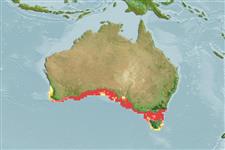>
Scombriformes (Mackerels) >
Arripidae (Australian salmon)
Etymology: Arripis: Latin, arripio, arripere = to take something suddenly.
More on author: Cuvier.
Environment: milieu / climate zone / depth range / distribution range
Ecologia
marino; salmastro benthopelagico; distribuzione batimetrica 0 - 80 m (Ref. 6390). Subtropical; 27°S - 44°S
Eastern Indian Ocean: southern Australia from Western Australia to Victoria and Tasmania.
Length at first maturity / Size / Peso / Age
Maturity: Lm ?, range 54 - ? cm
Max length : 96.0 cm SL maschio/sesso non determinato; (Ref. 33839); common length : 65.0 cm FL maschio/sesso non determinato; (Ref. 27977); peso massimo pubblicato: 10.5 kg (Ref. 27977); Età massima riportata: 9 anni (Ref. 27977)
Spine dorsali (totale): 9; Raggi dorsali molli (totale): 15-19; Spine anali 3; Raggi anali molli: 9 - 10; Vertebre: 25. Greyish or greenish black to steel-blue with yellow to blackish spots dorsally; silvery white ventrally. Pectoral fin pale yellowish, other fins translucent. Juveniles similar but with a greater number of spots and with dark fin margins. Length of upper lobe of caudal fin <29.9% (Ref. 9701).
Inhabit continental shelf waters including estuaries, bays and inlets (Ref. 6390). They school in shallow, open coastal waters, and can move over reefs in depths just sufficient to cover their bodies (Ref. 6390). Juveniles are found over soft substrates in shallow and sheltered coastal waters (Ref. 6390). They are often found over seagrass (e.g. Posidonia species) beds and in mangrove-lined (Avicennia species) creeks (Ref. 27967). Larger fish move into exposed, coastal waters, such as around rocky headlands, near reefs and the surf zone (Ref. 6390). Feeds on fishes (Ref. 2156). Minimum depth reported taken from Ref. 57178.
They are probably serial batch spawners (Ref. 6390).
Paulin, C., 1993. Review of the Australian fish Family Arripididae (Percomorpha), with the description of a new species. Aust. J. Mar. Freshwat. Res. 44(3):459-471. (Ref. 9701)
IUCN Red List Status (Ref. 130435)
Human uses
Pesca: commerciale; Pesce da pesca sportiva: si; esca: usually
Informazioni ulteriori
BibliografiaAcquacolturaProfilo di acquacolturaVarietàGeneticaElectrophoresesEreditarietàMalattieElaborazioneNutrientsMass conversion
CollaboratoriImmaginiStamps, Coins Misc.SuoniCiguateraVelocitàModalità di nuotoArea branchialeOtolithsCervelliVista
Strumenti
Special reports
Download XML
Fonti Internet
Estimates based on models
Preferred temperature (Ref.
123201): 15 - 18.5, mean 17.1 °C (based on 162 cells).
Phylogenetic diversity index (Ref.
82804): PD
50 = 0.6250 [Uniqueness, from 0.5 = low to 2.0 = high].
Bayesian length-weight: a=0.00955 (0.00352 - 0.02589), b=3.01 (2.79 - 3.23), in cm total length, based on LWR estimates for this (Sub)family-body shape (Ref.
93245).
Trophic level (Ref.
69278): 4.4 ±0.75 se; based on food items.
Resilienza (Ref.
120179): Medio, tempo minimo di raddoppiamento della popolazione 1.4 - 4.4 anni (K=0.26-0.30; tm=3-6; tmax=9).
Fishing Vulnerability (Ref.
59153): Moderate to high vulnerability (48 of 100).
Nutrients (Ref.
124155): Calcium = 35.7 [22.2, 62.5] mg/100g; Iron = 0.755 [0.498, 1.167] mg/100g; Protein = 19.8 [17.7, 21.8] %; Omega3 = 0.361 [0.228, 0.572] g/100g; Selenium = 30.2 [16.9, 52.3] μg/100g; VitaminA = 18.9 [7.6, 48.3] μg/100g; Zinc = 0.591 [0.446, 0.808] mg/100g (wet weight);
